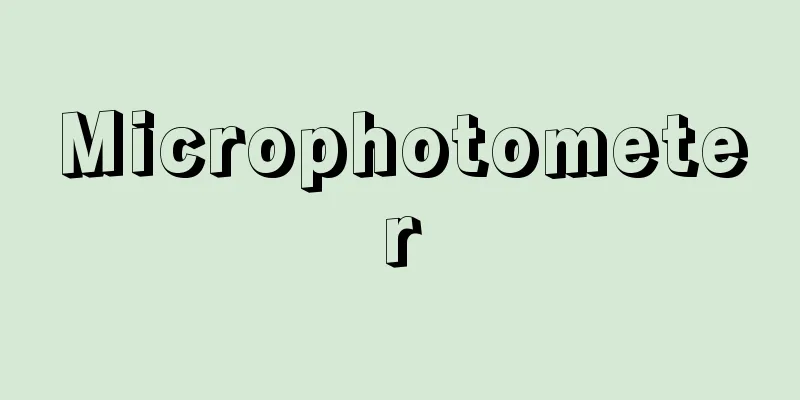Saussure, NTde (English spelling) SaussureNTde

|
…He also climbed many mountains, including Monte Rosa, and conducted scientific research on the geological structure, glaciers, and plant distribution of the Alps. He recorded his findings in four volumes of “Journeys in the Alps” (1779-96), which became a classic mountaineering journal and greatly influenced mountaineering enthusiasts. Nicolas Théodore de Saussure (1767-1845), who wrote “Chemical Investigations of Plants” (1804) and made great contributions to the field of plant physiology, was his son, and Ferdinand de Saussure, a famous linguist, was his great-grandson. [Tokuhisa Kyuuo] … From [Agriculture]…In the 1770s, the English clergyman J. Priestley (1733-1804) said that plants "purify the air" (by generating O2 ), and the Dutchman and Austrian court physician J. Ingenhuis (1730-99) showed that only the green leaves and stems of plants generate O2 . The Swiss clergyman J. Senebier (1724-1809) said that the presence of CO2 is necessary for O2 generation, and the Swiss N.T. de Saussure (1767-1845) proved that when light is irradiated on the green parts of a plant, organic matter is synthesized from CO2 and H2O . A little later, the German plant physiologist and agronomist J. von Sachs (1832-97) conducted extensive research on the physiology of plants, including photosynthesis, and compiled the results to become the founder of plant and crop physiology. … From [Fertilizer]...However, it was not until the 19th century that it became clear that plants grow by absorbing inorganic salts and water from the soil and obtaining carbon from the air through photosynthesis. In 1804, the Swiss Nicolas Théodore de Saussure (1767-1845) had already proven that plants absorb carbon dioxide through photosynthesis, but the "humus theory" proposed by AD Theer and others, which claimed that plants obtain carbon and other nutrients from humus in the soil, was still widely believed. It was 1940 when the German JF von Liebig proposed the "inorganic nutrition theory," which claimed that plants grow with water, carbon dioxide, and some inorganic salts. *Some of the terminology explanations that mention "Saussure, NTde" are listed below. Source | Heibonsha World Encyclopedia 2nd Edition | Information |
|
…また,モンテ・ローザなど多くの山に登り,アルプスの地質構造,氷河,植物分布などの科学的研究を行い,その記録を《アルプス旅行記》4巻(1779‐96)に著し,登山誌の古典として,登山愛好家に多くの影響を与えた。なお,《植物の化学的研究》(1804)を著し,植物生理学の分野に功績を残したニコラ・テオドール・ド・ソシュールNicolas Théodore de Saussure(1767‐1845)は彼の子であり,言語学者として名高いフェルディナン・ド・ソシュールは曾孫にあたる。【徳久 球雄】。… 【農学】より…イギリス人牧師J.プリーストリー(1733‐1804)は,1770年代に植物は〈空気を純化する〉(O2発生)とし,オランダ人でオーストリア宮廷医師J.インゲンホウス(1730‐99)は植物のO2発生は緑色の葉,茎だけが行うことを明らかにした。スイス人牧師スヌビエJ.Senebier(1724‐1809)はO2が発生するにはCO2の存在が必要であるとし,スイス人ソシュールN.T.de Saussure(1767‐1845)は植物の緑色部分に光を照射すると,CO2とH2Oから有機物が合成されることを証明した。それよりしばらく後の,ドイツ人植物生理学者さらに農学者ともいうにふさわしいザックスJ.von Sachs(1832‐97)は,光合成を含めて,広く植物の全般にわたる生理学研究を行い,それを取りまとめた植物・作物生理学の祖述者となった。… 【肥料】より…しかし植物が無機塩と水を土壌から吸収し,炭素は光合成によって空気から得て生長しているということが明らかになったのは19世紀になってからである。すでに1804年に植物が光合成によって炭酸ガスを吸収していることはスイスのソシュールNicolas Théodore de Saussure(1767‐1845)によって証明されていたが,なお植物は炭素その他の養分を土壌中の腐植から得ているというA.D.テーアらの〈腐植説〉が広く一般に信じられていた。この腐植説に対してドイツのJ.F.vonリービヒが,水と炭酸ガスといくつかの無機塩で植物は育つという〈無機栄養説〉を提唱したのは40年であった。… ※「Saussure,N.T.de」について言及している用語解説の一部を掲載しています。 出典|株式会社平凡社世界大百科事典 第2版について | 情報 |
>>: Saussurea gracilis (English spelling) Saussureagracilis
Recommend
Ancient Meaning of Manyoshu - Manyoshu Kogi
A commentary on the Manyoshu from the late Edo per...
Babelthuap
...The main island of the Republic of Palau, at t...
Utsunomiya Futaarasan Shrine
A shrine in Utsunomiya, Tochigi Prefecture. It is ...
Chondrus yendoi (English spelling)
…[Mitsuo Chihara]. . . *Some of the terminology t...
Synceros nanus (English spelling) Synceros nanus
…[Yoshinori Imaizumi]. … *Some of the terminology...
Ikebe Sanzan - Ikebe Sanzan
Year of death: February 28, 1912 (Meiji 45) Year o...
Odorik
An Italian Franciscan friar. Odoricus is the Engli...
Cutting charcoal - Kirikomitan
Generally, coal is classified by size at the coal ...
Koreans in Japan
Korea, which was a Japanese colony, became two nat...
Nordheim, LW (English spelling) NordheimLW
…Field emission was first observed by Robert Will...
bur marigold (English spelling) burmarigold
...The bracts are arranged in two rows, one insid...
Rest mass
In relativistic mechanics, the mass of a moving ob...
Akogiura - Akogiura
A beach between the Iwata River and the Aikawa Ri...
Shell-shaped fracture - Kaigarajodanko
… Cleavage refers to the tendency of certain crys...
Akis - Akis
In Greek mythology, she was a sea nymph and one o...





![Shichinohe [town] - Shichinohe](/upload/images/67cbc3a886e30.webp)



